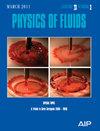撞击稀疏微柱阵列非润湿表面的液滴
IF 4.3
2区 工程技术
Q1 MECHANICS
引用次数: 0
摘要
实验研究了液滴和液滴撞击稀疏微柱阵列聚二甲基硅氧烷(PDMS)表面的润湿性。对于润湿在这些表面上的液滴,结合稳定因子和液滴下垂深度建立了接触线密度模型,以预测液滴是处于文泽尔润湿状态还是卡西-巴克斯特润湿状态。结果发现,在较稀疏的微柱阵列 PDMS 表面上的液滴处于文泽尔润湿状态,这表明撞击在这些表面上的液滴不可能发生完全回弹。对于液滴撞击稀疏微柱阵列 PDMS 表面的情况,研究发现,在固体分数为 0.022 的微图案表面上,液滴反弹的撞击速度存在一定范围。为了预测反弹液滴冲击速度的上限,建立了一个考虑液体浸入微柱结构深度的理论模型来进行预测,通过平衡动能和接触角滞后引起的能量障碍,可以得到反弹液滴冲击速度的下限。此外,对液滴最大扩散参数进行了拟合,发现其遵循 We1/4 的尺度规律。本文章由计算机程序翻译,如有差异,请以英文原文为准。
Droplet impinging on sparse micropillar-arrayed non-wetting surfaces
Wettability of droplets and droplet impinging on sparse micropillar-arrayed polydimethylsiloxane (PDMS) surfaces were experimentally investigated. For droplets wetting on these surfaces, the contact line density model combining stability factor and droplet sagging depth was developed to predict whether the droplets were in the Wenzel or Cassie–Baxter wetting state. It was found that droplets on the sparser micropillar-arrayed PDMS surfaces were in the Wenzel wetting state, indicating that a complete rebound cannot happen for droplets impinging on these surfaces. For the case of droplets impinging on sparse micropillar-arrayed PDMS surfaces, it was found that there existed a range of impact velocity for bouncing droplets on the micropatterned surfaces with a solid fraction of 0.022. To predict the upper limit of impact velocity for bouncing droplets, a theoretical model considering the immersion depth of liquid into the micropillar structure was established to make the prediction, and the lower limit of impact velocity for bouncing droplets can be obtained by balancing kinetic energy with energy barrier due to contact angle hysteresis. In addition, the droplet maximum spreading parameter was fitted and found to follow the scale law of We1/4.
求助全文
通过发布文献求助,成功后即可免费获取论文全文。
去求助
来源期刊

Physics of Fluids
物理-力学
CiteScore
6.50
自引率
41.30%
发文量
2063
审稿时长
2.6 months
期刊介绍:
Physics of Fluids (PoF) is a preeminent journal devoted to publishing original theoretical, computational, and experimental contributions to the understanding of the dynamics of gases, liquids, and complex or multiphase fluids. Topics published in PoF are diverse and reflect the most important subjects in fluid dynamics, including, but not limited to:
-Acoustics
-Aerospace and aeronautical flow
-Astrophysical flow
-Biofluid mechanics
-Cavitation and cavitating flows
-Combustion flows
-Complex fluids
-Compressible flow
-Computational fluid dynamics
-Contact lines
-Continuum mechanics
-Convection
-Cryogenic flow
-Droplets
-Electrical and magnetic effects in fluid flow
-Foam, bubble, and film mechanics
-Flow control
-Flow instability and transition
-Flow orientation and anisotropy
-Flows with other transport phenomena
-Flows with complex boundary conditions
-Flow visualization
-Fluid mechanics
-Fluid physical properties
-Fluid–structure interactions
-Free surface flows
-Geophysical flow
-Interfacial flow
-Knudsen flow
-Laminar flow
-Liquid crystals
-Mathematics of fluids
-Micro- and nanofluid mechanics
-Mixing
-Molecular theory
-Nanofluidics
-Particulate, multiphase, and granular flow
-Processing flows
-Relativistic fluid mechanics
-Rotating flows
-Shock wave phenomena
-Soft matter
-Stratified flows
-Supercritical fluids
-Superfluidity
-Thermodynamics of flow systems
-Transonic flow
-Turbulent flow
-Viscous and non-Newtonian flow
-Viscoelasticity
-Vortex dynamics
-Waves
 求助内容:
求助内容: 应助结果提醒方式:
应助结果提醒方式:


